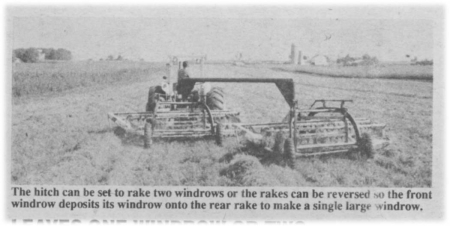
Ernest Steiner, Dalton, Ohio, has wanted a double rake hitch for years but he didn't like the units he saw on the market or that other farmers had built.
"My field roads and driveways are too narrow to accommodate the full width of a double wide rake. Also, most of them could not be easily switched from raking two windrows to a single large windrow. Many of the farmers I talked to were so disappointed with their double rake hitches, they'd gone back to using a single rake," says Steiner, who finally decided to design his own hitch. It worked so well last season, he's started to manufacture it.
Steiner worked with a local machine shop operator to design a hitch that would change positions easily on-the-go with one hydraulic cylinder. The hitch switches from transport to field position from the tractor seat and just as easily switches from laying two separate windrows to a single large one.
"It works far better than I ever expected. We've had absolutely no trouble with it, even on steep hillsides," says Steiner.
The two hitch posts and "gooseneck" were made out of 4-in. dia. steel pipe. A 2-in. dia., 16-in. stroke cylinder turns the front hitch one direction and a steering linkage that runs through the pipe frame, steers the rear wheels in the opposite direction. The result is that both rakes move far enough to the side so that tractor wheels don't run over either swath. To rake into a single large windrow, the position of the rakes is reversed so that the front rake deposits its windrow onto the rear rake. For transport the cylinder is pulled halfway so that both rakes trail in a straight line, one behind the other.
"We also discovered that in using the cylinder to steer hitch wheels around corners, you can make neat turns. Other double hitches leave messy windrows when the rakes swing around to turn," says Steiner.
There's been so much interest in the new hitch design, Steiner has already built several for neighboring farmers.
